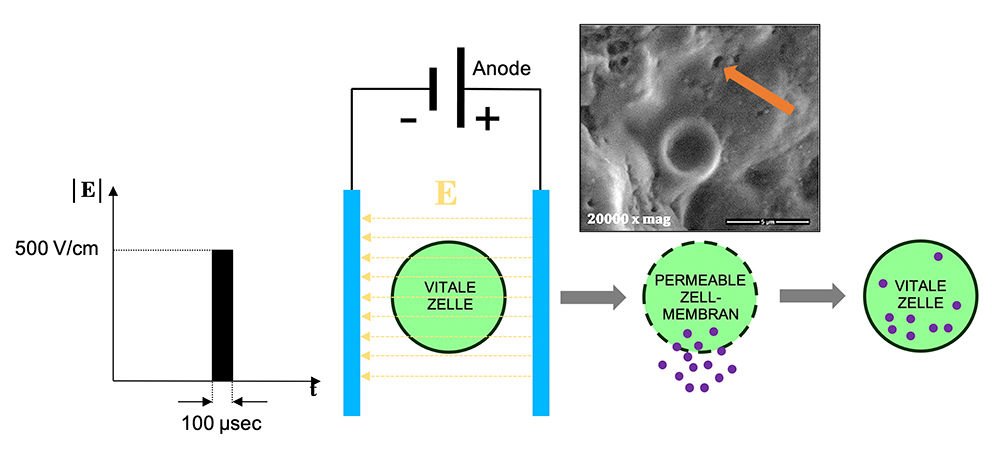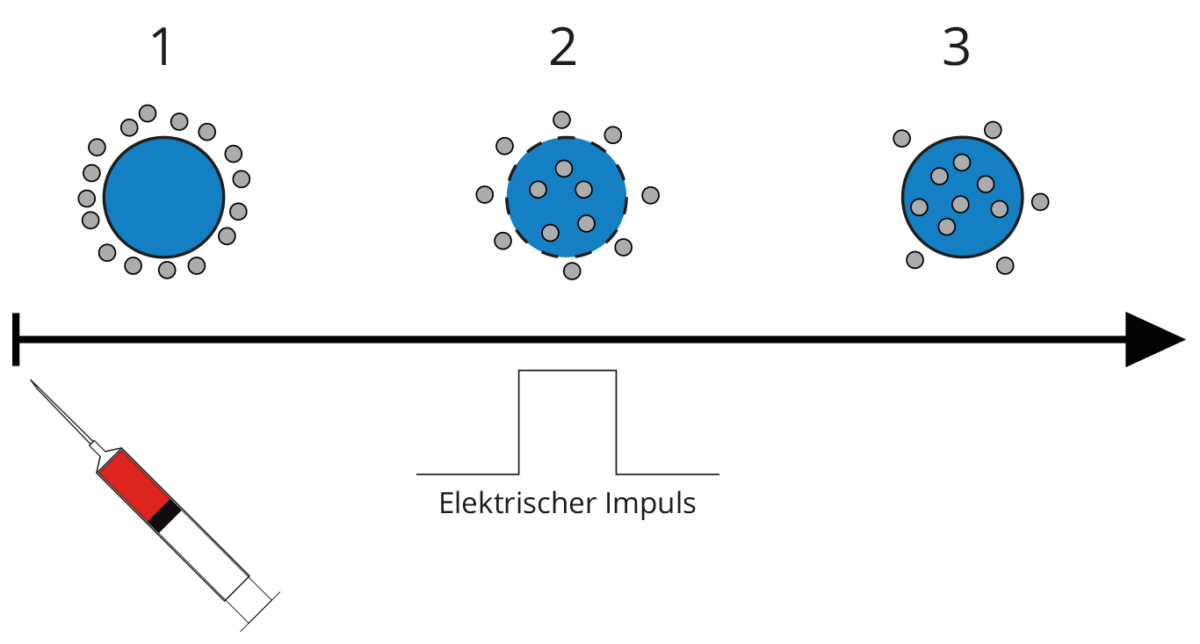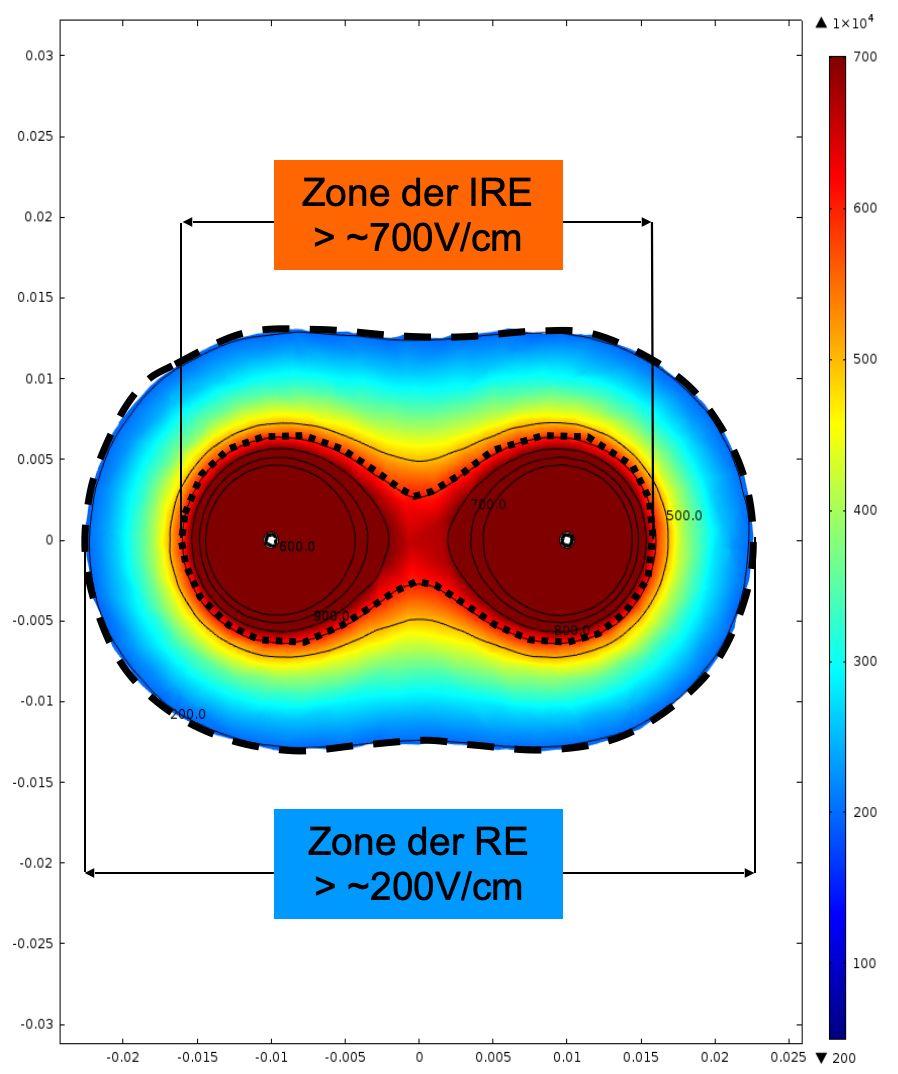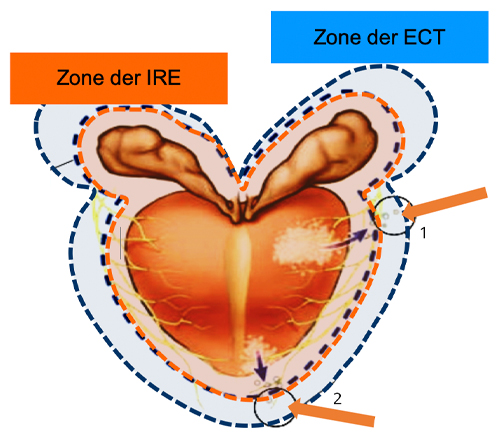Elektro-Chemotherapie
The original method of electroporation in medicine
Like Irreversible Electroporation (IRE), Reversible Electroporation (RE), which is the basis of Electrochemotherapy (ECT), uses short electrical pulses to create pores – holes – in cell membranes. While in IRE these pores no longer close and lead to cell death, the cell survives reversible electroporation – hence the name “reversible” – reversible; the pores close again.

Reversible electroporation has long been used in microbiology to introduce and remove molecules that have difficulty crossing the normal cell membrane, e.g., due to their size or chemical properties.
This principle can also be applied to cytotoxic substances such as chemotherapeutic agents that kill cells. This method is called electro-chemotherapy and was invented by Luis Mir in 19911,2. Chemotherapeutic agents that normally do not penetrate cell membranes, or penetrate them poorly, such as bleomycin or cis-platinum, are used for this purpose. When these chemotherapeutic agents are administered intravenously into the bloodstream, they spread throughout the patient’s body but preferentially penetrate electroporated cells, which have pores for unobstructed passage of chemotherapy molecules. Chemotherapy is thus focused on the area of electric fields: The effect of chemotherapeutic agents on electroporated cells is up to 1000-fold stronger than on cells in the rest of the body. Side effects of chemotherapeutic agents outside the treatment field are thus negligible.

2: Increased membrane permeability allows access to the cytosol
3: The membrane closes again Anticancer drug exerts its cytotoxicity
Electro-chemotherapy (ECT)
The new alternative to radiotherapy for prostate cancer recurrences
Prostate cancer has high recurrence rates. Within 5 years after radical prostatectomy (RPE), depending on tumor stage and aggressiveness, carcinoma is expected to return in 10 to 30% of all cases (Gleason 7 and 8, PSA < 10), even if the carcinoma was confined to the prostate.
The return of the carcinoma is also called “biochemical recurrence” because it is detected by a renewed rise in the PSA level above zero. Because it is unclear at this point exactly where the recurrence is located and reoperation is not possible, the entire “prostate bed,” the site where the prostate was removed and surrounding tissues, is irradiated in biochemical recurrences. This method is also used in so-called adjuvant radiotherapy, i.e. postoperative radiation, as local tumor control.

“Blind” irradiation of the prostate bed for
biochemical recurrence
Low precision, high side effects
Although in the case of a biochemical recurrence only the PSA value increases, no tumor foci can be detected on imaging – or in most cases they are not even searched for! – irradiation of the prostate bed is recommended in most cases. Even if the real reason for the PSA rise is an unknown lymph node or bone metastasis.
However, radiation therapy to the pelvis causes irreversible damage to the irradiated tissues and organs. This leads to chronic irritation of the bladder and rectum with frequent urination and defecation, but also to incontinence or voiding disorders. In addition, radiation therapy triggers chronic inflammation and scarring, and genetic damage, which in turn can trigger cancer.
Particularly serious is the fact that even radiotherapy does not guarantee a cure for prostate cancer, and it can recur afterwards. In most cases, however, it is then no longer possible to irradiate the patient again, as irreparable damage, known as radiation necrosis, occurs to the neighboring organs when the maximum dose is exceeded.
Treatment of biochemical prostate cancer recurrence without significant side effects with electrochemotherapy.
Electrochemotherapy (ECT) could offer a remedy. It can be used to treat the entire prostate bed, as with steel therapy, if a biochemical recurrence is suspected. However, unlike radiation therapy, ECT is a much gentler alternative. Healthy tissues and organs are hardly or not at all damaged by ECT treatment, since ECT primarily kills fast-growing cells and thus primarily tumor cells. Chronic damage, as with radiation therapy, is not expected with ECT treatment.
ECT can be used as often as desired and does not limit conventional therapy methods.
Therefore, ECT can also be repeated as often as desired – a great advantage over the one-time use of radiation therapy. And: If ECT does not provide the desired result, all conventional methods can be used without restriction.
IRE with extended
effectiveness
IRE Plus Electrochemotherapy (IR – ECT)
Electroporation processes are based on the same principle: pores are created in cell membranes using electrical pulses that generate electric fields. Strong pulses (up to 1500 V/cm) with many repetitions (90 pulses) lead to irreversible electroporation (IRE) with immediate cell death, less strong pulses (500 – 1000 V/cm) with lower number of pulses (8 pulses) lead to reversible electroporation with temporary formation of pores that close again and thus cell survival.
If we look at the field distribution around two electrodes during irreversible electroporation (see figure), we see that the field strength is high near the electrodes and decreases with increasing distance from the electrodes. Thus, if an electric field of sufficient strength is established for irreversible electroporation, the IRE field is spatially confined (Fig. 1, red area). However, it is always surrounded by a field of lower field strength (Fig. 1, green and blue area). In this area of lower field strength, reversible electroporation (RE) takes place – and it happens with every IRE treatment.
This fact can be used to expand the IRE treatment field. When a dose of bleomycin is administered during IRE treatment, it penetrates the electroporated cells in the area of reversible electroporation – where it leads to cell death via the mechanism of electrochemotherapy.
This is particularly useful in the case of aggressive tumors, e.g. prostate cancer Gleason 7b – 10, since aggressive tumor cells are distributed in the tissue far beyond the tumor focus that can be imaged due to their mobility – even outside the prostate (see figure). This explains the high recurrence rates after prostatectomy. The extension of the IRE ablation field by the peripheral ECT field offers the possibility to kill also these migrated tumor cells. And because ECT is particularly gentle on anatomical structures, widening the ablation field does not lead to further damage or side effects.
IR-ECT was developed in cooperation with our physicians and physicists at the VITUS Prostate Center and has been successfully applied hundreds of times.


Shown is a schematic representation of the prostate with two foci of carcinoma from which mobile tumor cells have migrated beyond the prostate capsule into the connective tissue surrounding the prostate (small black arrows). Surgical removal of the prostate along the prostate capsule leaves them in the “prostate bed” and is responsible for the frequent recurrences. In IRE treatment, the treatment field usually already extends beyond the prostate capsule (red area) and kills a portion of these tumor cells located outside the prostate. In combined IRE plus ECT (IR-ECT), the ECT treatment field extends even further into the prostate environment and also kills tumor cells that have migrated further. Tumor cells that have spread even further distally, e.g., by transport in lymphatic vessels, may also escape IR-ECT. The advantage of the peripheral ECT field is that it has minimal toxicity to anatomical structures such as the neurovascular bundle and bladder sphincter, so there is usually no fear of damage to these structures.
IRE plus electrochemotherapy (IRECT) – a gentle treatment method for aggressive carcinomas
Because IR-ECT extends the IRE treatment range, it is particularly useful for treating aggressive carcinomas.
For IR-ECT treatment, patients are administered a single dose of the chemotherapeutic agent bleomycin. The chemotherapeutic agent bleomycin has been used for many years to treat malignant tumors, especially testicular carcinoma. With conventional use of chemotherapeutic agents, multiple applications are usually required for effective treatment.
In ECT and IR-ECT treatment, the efficacy of the chemotherapeutic agent in the zone of reversible electroporation (RE) is enhanced many times (up to 1000-fold), so that a single application of the chemotherapeutic agent is sufficient to kill tumor cells.
The typical side effects of chemotherapy therefore do not usually occur.
IR-ECT is already successfully used in the treatment of skin and bone tumors. It is the gentlest method for treating large areas of tumorous tissue. This is because IR-ECT can treat cancer cells that are located further away from the IRE electrodes. No damage is caused to surrounding organs or tissues (e.g., bladder sphincter and bowel when treating the prostate).
Indications for
treatment with
combined
IR-ECT therapy
To date, it is not fully understood in which indications combined treatment of IRE and chemotherapeutic agents should take place. Further research is being conducted in this direction. Therefore, the VITUS Prostate Center currently only treats patients with IR-ECT who reject conventional therapeutic procedures such as radical prostatectomy (RPE) or radiation therapy (RT), or for whom such therapy is not possible or only possible with unacceptable side effects.
Potential applications for IR-ECT include:
- Patients with high-grade prostate cancer (at least Gleason 7b).
- Patients with prostate cancer that has already invaded the rectum or bladder wall
- Patients with incipient affection of the sphincter muscle, which could lead to incontinence
- Patients with complex focal recurrences after surgery, radiation treatment, or HIFU (high-intensity focused ultrasound).
- Patients with metastases in the lymph nodes, bones or, in certain cases, metastases in other organs
